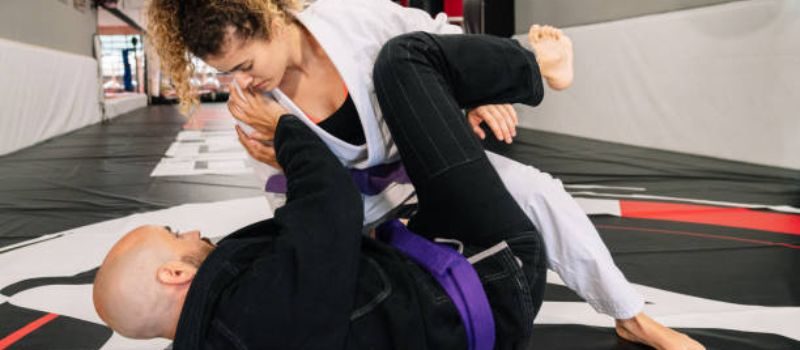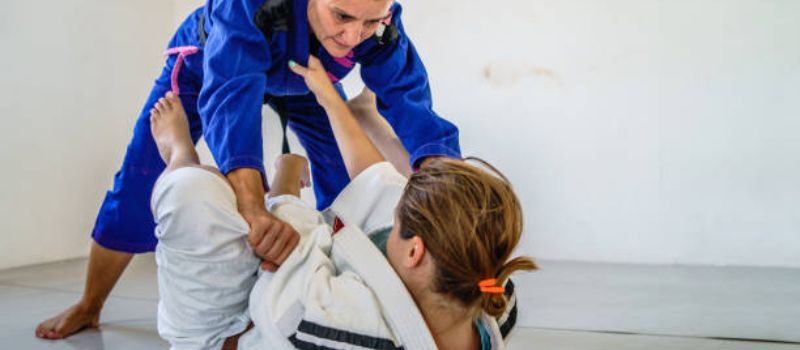Mastering the guard pass bjj technique is essential for any practitioner of Jiu Jitsu, as it is a fundamental move that allows you to bypass your opponent’s defense and secure a dominant position. Whether you’re just starting out or you’re an advanced jiu jitsu guard pass expert, honing this skill is vital for triumph on the mat.
Understanding the guard position in Jiu Jitsu
Before diving into the complexities of guard passing, it’s critical to grasp the concept of the guard jiu jitsu position. This defensive stance involves the bottom practitioner using their legs and hips to manage and counteract their opponent’s offensive moves. The guard is a fluid position that necessitates continuous motion and readjustment.
Importance of mastering the guard pass technique
Achieving proficiency in the gaurd pass technique is paramount in Jiu Jitsu, as it enables you to neutralize your opponent’s guard, take command, and improve your position. Lacking a robust guard pass, you’ll be confined within your opponent’s defenses, hampering your ability to launch potent attacks. A formidable guard can tilt the scales in your favor during a match, enhancing your prospects of victory.

Different types in Jiu Jitsu
In Jiu Jitsu, practitioners can choose from a variety of guard passes bjj, such as the torreando pass, smash passing, and the jump guard pass, depending on the scenario and the style of their opponent’s guard. Each type of pass, including the dynamic torreando pass, is accompanied by its own specialized techniques and tactics to effectively conquer your opponent’s guard.
Techniques for passing the bjj guard
To adeptly navigate through the bjj guard, it’s imperative to have an arsenal of guard passes techniques ready. These include pressure passing, which immobilizes your opponent with intense pressure to create pass opportunities, speed passing that relies on rapid, explosive actions to surprise your opponent, and combination passing that merges various methods to keep your adversary unsteady and uncertain.

Popular guard strategies
1 . Torreando pass :
A favored guard passing strategy also known as the bullfighter pass, involves manipulating your opponent’s legs with your arms while maneuvering around their guard. Renowned for its effectiveness against open guards, the torreando pass can be executed with both speed and precision.
2 . Smash passing :
Smash passing is another widely used guard passing strategy that employs substantial pressure and forward drive to collapse your opponent’s guard and achieve a superior position. The essence of successful smash passing lies in sustaining a solid base and relentlessly pushing ahead, making it a powerful tool among guard passes.
3 . Jump guard pass :
An advanced technique that also encompasses open guard passes, is a dynamic guard passing strategy that involves leaping over your opponent’s guard to gain a dominant position. This maneuver is particularly effective against adversaries who maintain a robust closed guard and hinges on the practitioner’s explosive athleticism and precise timing.
Tips for improving your passing guard in Jiu Jitsu
- Study and analyze different guard passing techniques and strategies.
- Focus on developing your timing and speed.
- Work on your mobility and agility to move fluidly around your opponent’s guard.
- Drill specific guard passing techniques repeatedly to build muscle memory.
- Spar with different training partners to expose yourself to various guard styles and defenses.
Passing guard in Gi and No-Gi Jiu Jitsu
Guard passing techniques, including those specific to guard BJJ, can vary between Gi and No-Gi Jiu Jitsu. In Gi Jiu Jitsu, the gi’s presence offers additional grips and control opportunities, enabling the use of collar and sleeve grips to refine your technique
In No-Gi Jiu Jitsu, where there’s an absence of a gi for grips, the focus shifts to body positioning and pressure to execute passing guard BJJ no gi. No-Gi guard passing demands a profound comprehension of weight distribution and base control to effectively circumvent your opponent’s guard.

Advanced techniques
1 . The rubber guard :
The rubber guard is a unique guard position that allows you to control your opponent’s posture and limit their options. It requires flexibility and precise control to execute effectively.
In No-Gi Jiu Jitsu, where there’s an absence of a gi for grips, the focus shifts to body positioning and pressure to execute passing guard BJJ no gi. No-Gi guard passing demands a profound comprehension of weight distribution and base control to effectively circumvent your opponent’s guard.
2 . The turtle guard :
The turtle guard is a defensive guard position where the practitioner on the bottom assumes a turtle-like posture, making it difficult for their opponent to pass their guard. By understanding and mastering these advanced techniques of this , you will have a wider range of options and be able to adapt to different situations on the mat.
In No-Gi Jiu Jitsu, where there’s an absence of a gi for grips, the focus shifts to body positioning and pressure to execute passing guard BJJ no gi. No-Gi guard passing demands a profound comprehension of weight distribution and base control to effectively circumvent your opponent’s guard.
Training drills and exercises
To enhance your skills, it is important to incorporate specific training drills and exercises into your routine. Here are a few drills that can help you
In No-Gi Jiu Jitsu, where there’s an absence of a gi for grips, the focus shifts to body positioning and pressure to execute passing guard BJJ no gi. No-Gi guard passing demands a profound comprehension of weight distribution and base control to effectively circumvent your opponent’s guard.
- Guard retention drills:
Practice maintaining your guard against a resisting opponent to improve your defensive skills. - Reaction drills:
Have a training partner randomly switch between different guard positions, forcing you to adapt and pass their guard. - Speed passing drills:
Perform this against a resisting opponent while focusing on speed and explosiveness. - Resistance training:
Spar with partners who have strong guard games to challenge yourself and improve your passing under pressure.
Common mistakes to avoid when passing the guard in Jiu Jitsu
There are common mistakes that practitioners often make. These mistakes can hinder your progress and make it easier for your opponent to defend against your passes. Some common mistakes to avoid include:
- Lack of pressure:
Failing to apply sufficient pressure can allow your opponent to maintain their guard and make it difficult for you to pass. - Staying in one position:
Being stagnant and not actively transitioning between passes can give your opponent time to react and counter your movements. - Neglecting grips:
Neglecting to control your opponent’s grips can give them opportunities to regain their guard or execute submissions. - Overcommitting:
Overcommitting to a single pass without considering your opponent’s counters can leave you vulnerable to sweeps and submissions. - Poor weight distribution:
Failing to distribute your weight properly can make it easier for your opponent to off-balance you and defend against your passes
Conclusion
Mastering the bjj guard pass technique is essential for any Jiu Jitsu practitioner who aims to dominate their opponents. By understanding the guard position, studying various strategies, and consistently practicing drills and techniques, you will develop the skills necessary to pass any guard. Remember to avoid common mistakes and continue expanding your knowledge through available resources. With dedication and perseverance, you will unlock mastery in how to pass guard bjj and elevate your passing the guard brazilian jiu jitsu game to new heights.
Frequently Asked Questions (FAQs)
Q: How long does it take to master the guard pass technique in Jiu Jitsu?
A: The time it takes to master this technique varies from person to person. It depends on factors such as natural ability, training frequency, and dedication. With consistent practice and a focused training approach, it is possible to see significant improvements within a few months.
Q: Can I use the guard pass technique in self-defense situations?
A: While this technique is primarily used in sport Jiu Jitsu, certain aspects of it can be applied in self-defense situations. The principles of balance, control, and positioning learned through guard passing can be valuable in real-life encounters.
Q: Are there any specific conditioning exercises that can improve my guard passing abilities?
A: Yes, there are conditioning exercises that can target the specific muscles and movements used in guard passing. Exercises such as squats, lunges, and core strengthening exercises can help improve your overall strength and stability, making your guard more effective.
Q: Is it necessary to learn both Gi and No-Gi guard passing techniques?
A: While it is not necessary to learn both Gi and No-Gi guard passing techniques, having knowledge of both can greatly enhance your overall game. Each style presents its own unique challenges and opportunities, and being well-rounded in both can make you a more versatile and adaptable practitioner.
Q: What should I do if my opponent has a strong guard and is difficult to pass?
A: If you encounter an opponent with a strong guard, it is important to remain patient and focused. Look for openings and weaknesses in their defense, and try different techniques and strategies to break through. It may take time and persistence, but with practice, you will develop the skills to pass even the toughest guards.


